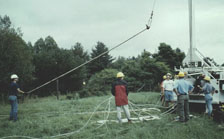 |
The Toxic Substances Hydrology Program provides objective scientific information on environmental contamination to improve characterization and management of contaminated sites, to protect human and environmental health, and to reduce potential future contamination problems. Read more about the Toxics Program
|
 |
 |
 |
|
|
|
|
|
| |
|
|
| |
|
|
| |
|
|
| |
|
|
| |
|
|
| |
|

USGS scientists positioning drill stems so equipment can be lowered into a bedrock well to conduct a tracer test in fractured rock. A series of tracer tests were conducted to identify interconnected fractures at the site -- from the Mirror Lake Site
|
|
|
|
|
Selected New Publications
Mercury sources, distribution, and bioavailability in the North Pacific Ocean--Insights from data and models: Sunderland, E.M., Krabbenhoft, D.P., Moreau, J.W., Strode, S.A., and Landing, W.M., 2009, Global Biogeochemical Cycles, v. 23, no. 2, p. 1-14, GB2010, doi:10.1029/2008GB003425.
The occurrence of antibiotics in an urban watershed--From wastewater to drinking water: Watkinson, A.J., Murby, E.J., Kolpin, D.W., and Costanzo, S.D., 2009, Science of the Total Environment, v. 407, no. 8, p. 2,711-2,723, doi:10.1016/j.scitotenv.2008.11.059.
Mercury cycling in stream ecosystems--1. Water column chemistry and transport: Brigham, M.E., Wentz, D.A., Aiken, G.R., and Krabbenhoft, D.P., 2009, Environmental Science and Technology, doi:10.1021/es802694n (Advanced Web release).
Upcoming Publications
Glypohosate and other pesticides in vernal pools and streams in Parks: Battaglin, W.A., Park Science (IN PRESS).
The effect of planting method on Populus Spp. and Salix Sp. mortality and growth at a petroleum-hydrocarbon contaminated shallow aquifer: Cook, R.L., Landmeyer, J.E., Atkinson, B., Messier, J.P., and Guthrie Nichols, E., International Journal of Phytoremediation (IN PRESS).
Hydrodynamic control of phytoplankton loss to the benthos in an estuarine environment: Jones, N.L., Thompson, J.K., Arrigo, K.R., and Monismith, S.G., Limnology and Oceanography (IN PRESS).
|
|
|
|
USGS and Montana Tech of the University of Montana co-sponsor the Special Session Diurnal Biogeochemical Processes in Rivers, Lakes, and Shallow Groundwater at the 2009 GSA Annual Meeting, Portland, Oregon, October 18-21, 2009
USGS and Colorado State University co-sponsor EmCon2009-2nd International Conference on Occurrence, Fate, Effects, and Analysis of Emerging Contaminants in the Environment, Fort Collins, Colorado, August 4-7, 2009
USGS and EPA cosponsor the USGS Toxic Substances Hydrology Program National Point Source Research Meeting, San Diego, Calif., January 26-29, 2009
The USGS cosponsors the special session Hydrogeological Research Sites and Observatories at the 2008 AGU Fall Meeting, San Francisco, California, December 15-19, 2008
USGS co-sponsors workshop on Diurnal (Diel) Cycling of Chemical Constituents in Surface Water and Related Media—Scientific and Regulatory Considerations, Trenton, New Jersey, December 12, 2008
USGS is co-sponsoring the short course Environmental Fate and Effects of Emerging Contaminants at the SETAC North America 29th Annual Meeting, Tampa, Florida, November 16-20, 2008
USGS sponsors the special session In Situ Approaches for Measuring Biodegradation Potential and Rates in Subsurface Environments at the 2008 Joint Annual Meeting, Houston, Texas, October 5-9, 2008
USGS and the University of Wisconsin-Madison are cosponsoring the joint session A Celebration of Soil Science, Solute Transport, and National-Scale Water-Quality Research: In Honor of Jacob Rubin at the 2008 Joint Annual Meeting, Houston, Texas, October 5-9, 2008
|
|
|
 |

|

|